
Written by: Dr. Dushka H. Saiyid - Posted on: April 30, 2013 |  Comments | 中国 (Chinese)
Comments | 中国 (Chinese)
Google Translation: اُردو | 中文
Pantanal, 54,000 square miles of the largest freshwater wetland in the world, has been declareda UNESCO World Heritage site. From November to March, during the rainy season, 78 percent of the Pantanal is submerged in water, and becomes a rich fertile habitat. Wildlife was disappearing with the expansion of cattle ranching, but the government encouraged eco-tourism, so the ranchers or pantaneiros now have an alternative source of income, and an incentive to preserve wildlife.
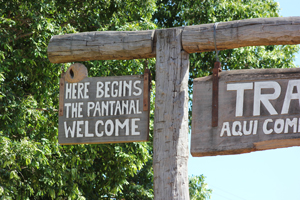 |
Our flight landed in Cuiaba, the nearest access town to Pantanal. The minute we got onto the Transpantaneira, a raised dirt road of 147 km that runs through the heart of the Pantanal, we were surrounded by wildlife. The most common sight was that of capybaras, large rodent like creatures, roaming in groups by the side of the road. Further down, a caiman was crossing the road at a leisurely pace. Belonging to the family of alligators, this reptile is one to two meters long and is an amphibious carnivore. It was easy to spot them in the marshy water under any of the 126 bridges that dot the Transpantaneira. Tito, our guide, kept rattling off the names of the colourful birds in the foliage, till he suddenly slowed the car down, pointing to a jaguar and two cubs crossing the road. The mother disappeared in the bushes, while the cubs played in full view for a few seconds. I was jetlagged, and too slow with the camera.
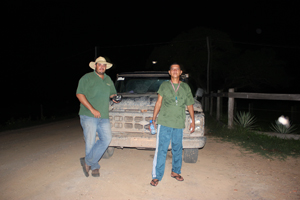 |
| Getting ready for the night safari |
We went for a night safari after dinner. Tito stood in the rickety open jeep that seemed to belong to the World War I era, and flashed a powerful light into the shrubbery, hoping to catch another glimpse of that grand feline. The clatter of the jeep shattered the silence of the night, and some one spotted two eyes glowering in the foliage, but they disappeared. I was happy to return to the safety of the Lodge.
We saw dawn break from the verandah of our room, and as the golden-pink light spread, the loud chirping of birds filled the air. I ran around the grounds of the Lodge taking pictures, but their sheer variety was dazzling. My favourite was a cluster of hyacinth macaws perched in the tree; seemed to be posing for the camera. The Jaguar Ecological Reserve was a bird watcher’s paradise!
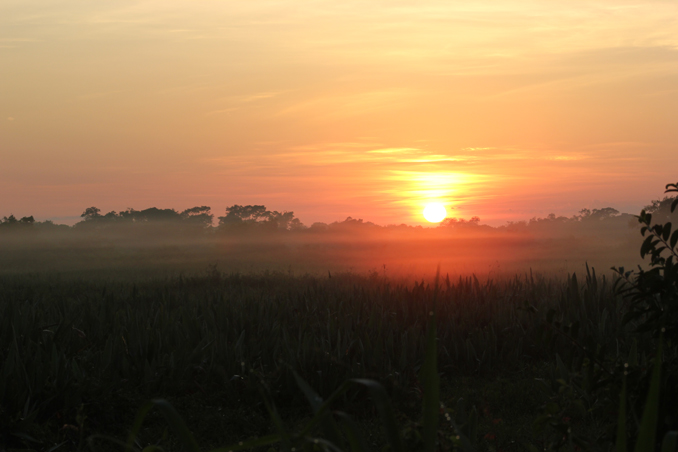 |
| Sunrise in Pantanal |
Our trip down the river from Porto Jofre in the searing November sun didn’t yield results. Disappointed, we were preparing to leave the next morning, when Tito hysterically called out “jaguar, jaguar!” and we ran to his car, only to discover that tourists staying in our Lodge were chasing a jaguar, who was running by the side of their jeep. It was a dumb thing to do, and the jaguar soon disappeared into the shrubbery. We said goodbye to the Jaguar Lodge and its friendly staff, and headed back to Cuiaba, occasionally stopping to photograph the colourful birds. I even spotted a Toucan, and managed a reasonably good shot.
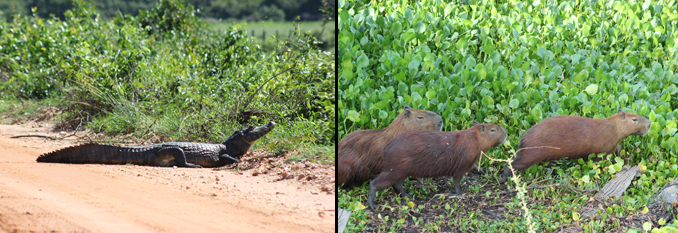 |
| Caiman Capybaras |
An hour into our long drive back, Tito’s laser eyes spotted a jaguar on the road. Our chatter stopped as Tito switched off the car’s engine and let the car roll. There it was, loitering in the middle of the Transpanteneira. Tito got out of the car on tiptoes, and I followed with my camera cocked. My two sisters sat in the car, frozen, fearful that any sound would scare away the cats. A big jaguar crossed the road and disappeared to the left side, but we seemed to have caught the attention of his spouse, who just stood there riveted, staring at us. Maybe it was the colour of my shirt, which attracted her attention; the travel guidebook had warned that red colour scares animals. My mistake! And while I stood on the bridge clicking madly, with nothing but an open space of 30 meters between us, her partner emerged from the shrubbery on the left, and re-crossed the road to join her; large, muscular and regal, ignoring our presence, he went to her and both slunk away into the foliage. My heart pounded hard with fear, as I struggled to keep my hand steady, but I was transfixed and spellbound by the majesty of this creature. At long last I had encountered a jaguar at close range, and taken some nice shots. We drove to the Cuiaba airport in a jubilant mood, sad to say goodbye to the Pantanal and our guide.
The government ban on arms and hunting, and effective steps for conservation and preserving the ecosystem have helped man and beast co-exist peacefully in the Pantanal.
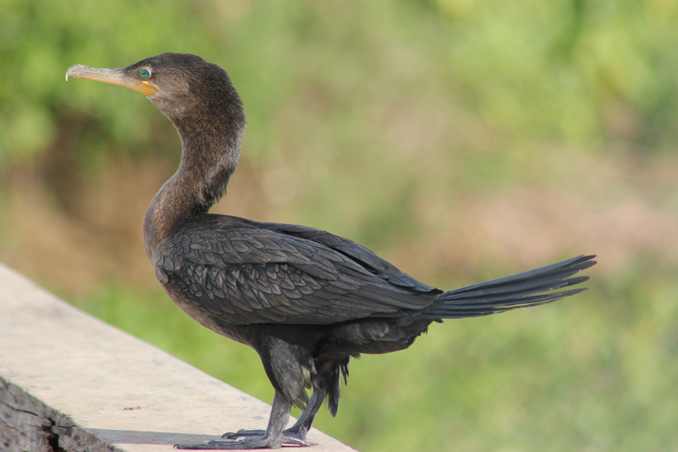 |
| Neotropic Cormorant |
Click to view picture gallery